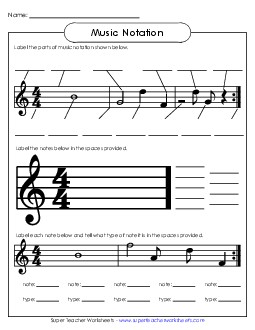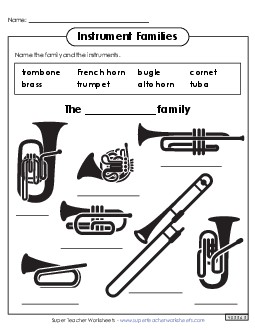Art & Music Worksheets

Learn about colors and color words.
Basic ShapesLearn about circles, squares, rectangles, triangles, trapezoids, and hexagons with these printable worksheets.
Coloring PagesThis area has a collection of coloring pages for children of all ages.
Finish-the-Picture WorksheetsThese worksheets have incomplete drawings. Finish the drawings and color them in.
Learning to Draw WorksheetsLearn to draw your favorite animals and objects. These activities with step-by-step instructions will make it a breeze.
Music Worksheets - Instrument FamiliesThis page has worksheets and puzzles to help students learn about the different instrument groups/families.
Music Worksheets - Musical Notation, Beats, & NotesLearn basic music notes, rests, and music notation.
Full Website IndexA full index of all Math, ELA, Spelling, Phonics, Grammar, Science, and Social Studies worksheets found on this website.

Art and music are essential components of the elementary and middle school curriculum, offering students unique opportunities to develop a wide range of skills. Through art, students can enhance their creativity, fine motor skills, visual-spatial awareness, and self-expression. Creating personal art projects, whether through drawing, painting, or sculpture, helps students explore different materials and techniques while learning about color theory, shapes, and textures. In music, students develop auditory skills, rhythm, and coordination while learning to play instruments, sing, or understand music theory. Both subjects also promote critical thinking, as students analyze artistic and musical works, make decisions about their projects, and solve creative challenges.
Art and music education are important because they help foster a well-rounded development, going beyond traditional academic subjects. They support emotional growth by providing students with a means of expressing feelings and ideas that may not be easily conveyed through words. Additionally, engaging in art and music has been shown to enhance cognitive functions, such as memory, concentration, and problem-solving skills, which can positively impact learning in other subjects like math and language arts. Furthermore, these subjects encourage collaboration and communication when students work on group art projects or participate in a band or choir.
Teachers can use printable art and music materials from Super Teacher Worksheets to engage students in these important areas. In art classes, they often start with foundational techniques and gradually introduce more complex projects, encouraging students to experiment and find their style. Teachers may use art history lessons to inspire creativity and connect students with different cultures and time periods. In music classes, teachers employ interactive activities, such as rhythm games, instrument playing, or singing, to make learning enjoyable and accessible. Incorporating technology, like digital art tools or music composition software, is another way to engage students. Art and music education helps students build confidence in their abilities and fosters an appreciation for cultural and artistic expression.








